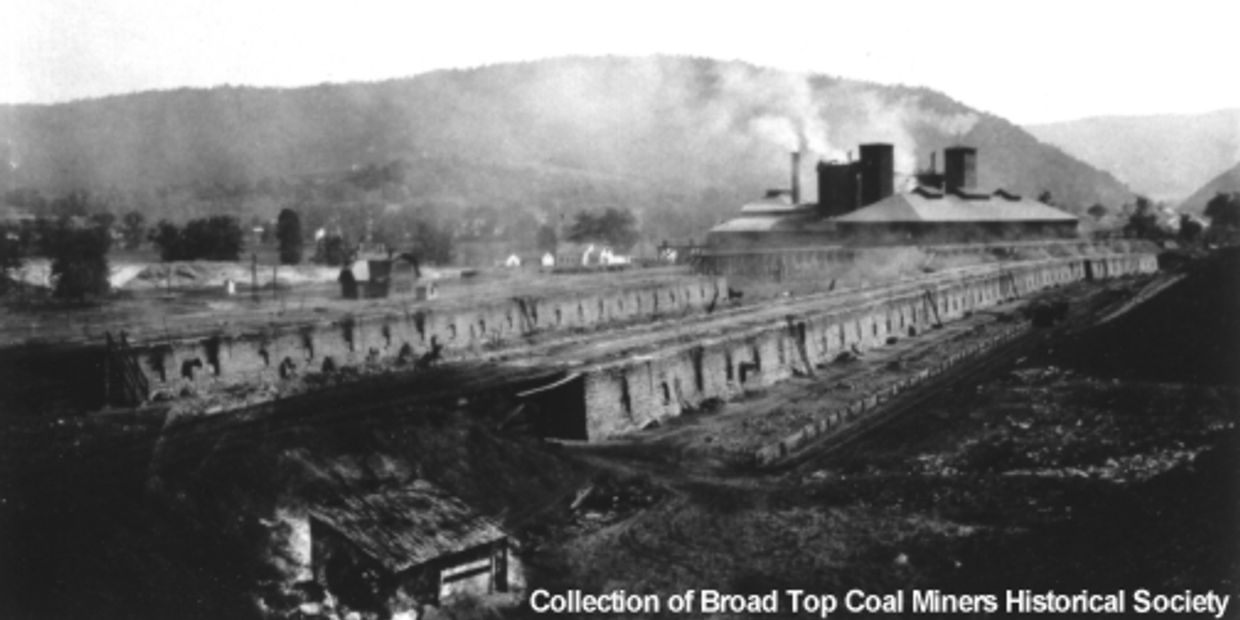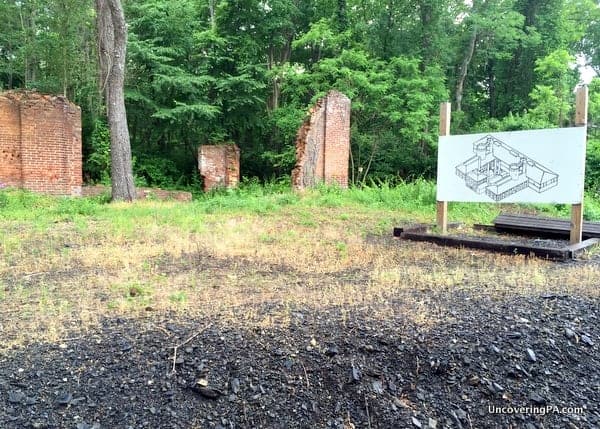I have the stupid question …what was this furnace used for ?
In all of this I never even thought to ask what the furnace was for. I assumed I guess that it was for iron or some other smelting process but its a good question it certainly could have been many things.
Wikipedia says iron smelting.
So who ever smelt it delt it ? 
Iron furnaces were all over the Northeast back in the day. We have the remnants of one near me in Kent, CT where only the stone house and brick furnace remains. The rest has long since returned to the earth.
This photo was taken 20 years ago. At the time, you could go in under the steel reinforcement. Today it is entirely fenced off…
These small furnaces were later replaced with much larger operations like the Rockhill Furnace in PA that was serviced by the EBT. Very little remains of that one, a few brick pillars and foundations. By comparison it was huge including an array of coke ovens…

Okay I can probably google this but I’m lazy. Does anyone know how this type of operation worked. So in this conversation we have been talking about the furnace and the blower. So I am taking it that these were coal fired furnaces that used bellows or blowers to super heat the burning coal. I get that part. But okay now we have a hot fire and solid rock ore. What happens in the 1800’s iron production facilities to get the ore and the fire together to give me a cast iron tie plate for my railroad. Where is the melting pot in all of this, how do they deal with the base rock surrounding the iron, Once they have the iron melting in a pot how do they deal with the slag, and once they have molten iron are they then casting ingots or would this go straight to a foundry located at the same facility.
Here in my neck of the woods we have an aluminum plant. They have nothing to do with aluminum ore. They bring in ingots, melt, and pour. And not so long ago they even melted a large portion of it at another plant and trucked the molten aluminum cross town on semi trucks. Even when the Silver valley was going big time they would mine the rock in one place, concentrate the ore in another, and send the concentrate to a smelter to make ingots.
So I am curious if these are all in one facilities where ore is turned into a cast iron part or is this only taking ore to ingot?
This project is making my mind numb. I really wish they would pack the thing up and deliver it to me so I could borrow it to look at and measure. As I go to identify each detail I start to see more and more.
I’m not a student of iron making, but I do know that the stone/brick furnaces like Carrick and Kent burned charcoal as fuel. Later in the evolution of the process, coke was produced using charcoal to fire the coke oven and the hotter burning coke used in the blast furnaces.
Interesting. I would have bet a million bucks that regular coal was used through out. And in my ignorance I had heard of coke ovens but I always thought that was a type and not a reference to the fuel. Having heard the term “coke” I don’t recall ever knowing that coke was a type of fuel.
I had to google this. So here all this time I was thinking coal. And having no idea what coke is, I find out its . . .wait for it . . .coal.  So basically they made charcoal to then heat coal in the absence of oxygen to produce coke. . .did I get that right? And why I still have not read nor do I really care unless someone just wants to tell me.
So basically they made charcoal to then heat coal in the absence of oxygen to produce coke. . .did I get that right? And why I still have not read nor do I really care unless someone just wants to tell me.
Your Google search has already turned up more than I know on the subject. In order of BTU’s produced, I believe it’s Wood, Charcoal, Coal then Coke being the highest. At that point in history, Natural Gas and Oil hadn’t really been developed yet. I’m fuzzy on the time periods, but gas was used as a lighting fuel in cities very early on, but probably due to the volume needed wasn’t used for much else.
If you want to go down the steel mill black hole, and are on Facebook, join the Steel Mill Modeler’s group. Some amazing modeling going on there, and tons of great information.
That’s actually tempting. While I have pretty well disavowed Facelessbook I do still “use” it to lurk in groups. And that might be a fun one. We have nothing even close to that sort of operation in the NW. And I have seen elements of steel mills that are fascinating. I have mentioned in another post that I log Pig Iron cars.
That all one print? Or do you print it in pieces and then assemble? If so, how many pieces? How do you decide where to break it up?
I have too many questions…
Jim,
Its not too many questions. They are all great questions. Not one piece for sure. So far I have 10 pieces. As to how to break it up. . . Well I suppose thats really up to the person making the kit. For me, I like to make as few pieces as possible. So I combine a lot of sub assemblies into one piece. But you have to be careful when modeling in CAD to make a real model that must be assembled. When I first started this I found I was making two separate pieces but they were actually intertwined so they couldn’t be printed separately because then you could never assemble it. So you have to find a logical place to break things. Or join them.
I do think in some respects being a model car guy who put together who knows how many car models has helped because I can see how things will be assembled. As I design I am “assembling” the model in my head.
One way to view it is you are making a 3D puzzle. So you have to be thinking with each piece “how will I assemble it”. When it comes down to it, its surprising how intuitive it is. With your scratch building abilities Jim, I bet you would easily see it too. When we scratch build we do the same thing. We not only see the big picture, but we see the pieces, and we make them, and we assemble them. This is really no different. Its one of the reasons I have become such a passionate defender of the technology. I see so much of the same skill sets in scratch building as I do CAD modeling.
Maybe its me. Maybe I am just strange. But I think the lines between CAD modeling and scratch building are very blurry. At least the way I approach it, I think the modeling process is much the same just the tools are different.
Something else I will add is the one thing I have learned, mainly in designing model kits for my friend Mike, is when I am all done, and I say the design is complete, I then take it all apart in the CAD program. You do this by “turning” all the pieces off. This means you can’t see any of the pieces. Then I start to turn them on one by one. This allows me to “assemble” the model in a virtual world.
And guess what, you still won’t get it right the first go. It requires test prints, test fittings, and eventual tweaking. I just completed a new design for Mike. It’s perfect. On my computer screen it all looks great and fits together no problem, and I can assemble it. Well he did the test prints and assembly. We have a meeting Friday where he is going to give me a laundry list of problems.
One thing that you learn quickly is computers are precise to the Nth degree. But even the best resin printer with the finest resolution, they don’t print no where near as precise as the computer generates them. Tolerances must be made. Changes must be made. For one resin “swells”. If you design a hole and a peg where the diameters are the same the printed peg wull.never fit in the hole. The hole is always smaller and the peg always bigger. So you must adjust one or the other or both so there is some fudge factor to get them to fit.
To further complicate things, you have to decide what can and will be hollow verses solid. Solid pieces are a waste of resin. In the model above, the big tub would be a giant waste of resin if I made it solid.
But if you make a piece hollow, then it can’t be sealed. At least not in resin printing. Otherwise you trap uncured resin inside the hollow. So you have to either make two pieces or engineer a drain hole. And even that takes some thought, because you have to orientate the piece in the machine so it is constantly draining.
So again in my above model the big blower tub is two pieces. The main drum body and a lid. It will be printed in orientation that the top of the tank is pointed down (resin printers print upside down) so resin constantly drains out. And then for assembly I will glue the lid on.
Devin
Found some info on the Internet that might be helpful:
“Iron was originally smelted in bloomeries, furnaces where bellows were used to force air through a pile of iron ore and burning charcoal. The carbon monoxide produced by the charcoal reduced the iron oxide from the ore to metallic iron.”
Also, this website might help:
Bob
Bob,
I really appreciate the link. As something that is not at all part of Western history, I am finding this fascinating. You can only learn so much about logging and silver mining before it becomes mundane and monotonous. Still interesting, but monotonous. So this departure into another way of life in another part of the country is really interesting. It similar to BDs coal mine build. Another thing that is just not at all a part of the heritage in my neck of the woods.
Looks great, I’ll take two!



